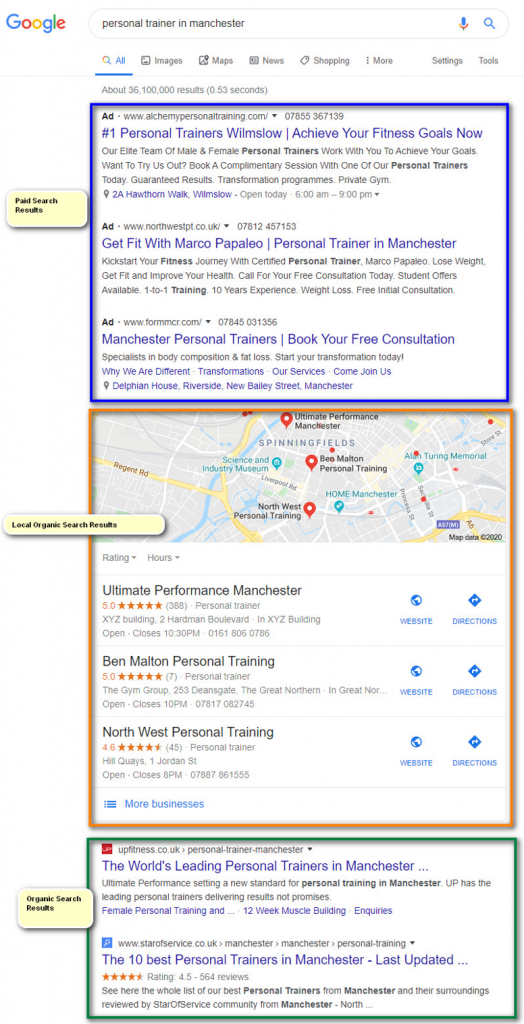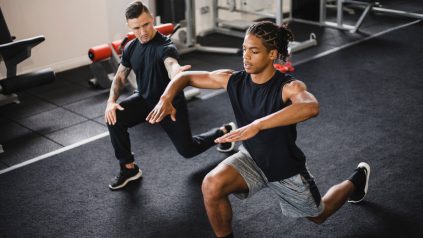SEO stands for Search Engine Optimisation. In a nutshell, this is getting a website to appear as high as possible within search engine results pages (SERPs).
For reasons we’ll come onto, SEO for personal trainers is invaluable. So, if you’re trying to grow your PT business or fitness studio, knowledge of SEO is important. You need to optimise your website so that it appears high up in search engines.
A solid SEO strategy gives you the best possible chance of getting your website and business in front of potential clients. However, it’s easier said than done. The world of SEO is competitive, and it often takes time before you start to see results and reap the rewards.
Patience is key to personal trainer SEO, but you’re in the right place. Here’s our guide to SEO for personal trainers.
Choose keywords for your website

Keywords are a crucial part of any successful SEO strategy. These are words and phrases that Internet users type into search engines. For example:
- personal trainer near me
- personal trainer in Manchester city centre
- cheap fitness instructors in north London
Keywords allow users to find websites that match their search query. So, if your website isn’t optimised with relevant keywords, very few people, if any at all, will land on your site via SERPs.
To get started, write a list of keywords you want your website to be associated with. This will determine what you’re discovered for and help you define what content you want to include on your website—more on that later.
Related: How to pick your first SEO keywords
SEO for personal trainers: keywords
Producing a list of keywords for your website is easier than you might think.
Tools like Google Keyword Planner show how much search traffic is generated by individual keywords, and suggest related keywords you may not have otherwise considered.
More advanced, paid-for tools like SEMRush and AHRefs are available for those already familiar with keyword research. These tools help you to identify keyword volume and how competitive keywords are—ie how easy it’ll be for your site to rank for them.
Your chosen keywords should appear on the homepage of your website, in headings and in page meta descriptions. More on this later.
Optimise your keywords for local search
When picking your keywords, the key thing is to think granular and think local.
This will give you a much better chance of success than trying to optimise your site for broader, less targeted terms like ‘personal trainer, ‘gym’, or ‘weight loss’.

According a study by Go Gulf, nearly half (46%) of all Google searches seek local information, while 97% of people use search engines to find local businesses. So, it’s clear you need a local, tailored approach when it comes to your keyword strategy.
For example, if you’re a PT based in Birmingham—optimising for ‘personal trainer Birmingham’ will stand you in much better stead for attracting clients than optimising for just ‘personal trainer’.
Don’t underestimate the power of Google Maps either when working on your SEO strategy. This is another place many people find local services, so ensure your business is visible.
Related: 10 ways to optimise your website for local SEO
SEO for personal trainers: organic vs paid
Of course, these are all examples of free tactics—or organic SEO, whereby people find your website naturally. However, if you’ve got more money to play with, you might also want to invest some of it into paid search marketing (PPC), as paid search results appear above organic in the SERPs.
You can usually tell which placements are paid for, as they’ll be clearly marked as an advert.

Choose your content management system

A content management system (CMS) allows you to create, edit and publish content on your website. You can use a CMS to:
- create your own unique domain name
- create design themes and templates
- write and publish articles and blogs
- make quick changes to pages
- upload multimedia
Depending on your budget, you can either run your own CMS or outsource it to a marketing agency. You’ll also have to ask yourself how much control you want over this part of your SEO strategy. You’ll have much more control over things if you do it alone.
WordPress, Wix and Squarespace are some of the most popular platforms for website hosting. They’re easy to use, and you can do a lot with them.
Related: How to choose the right content management system
Create engaging content
Having a good CMS in place is great, but it’s only half the battle when it comes to your content. You also need to create content that resonates with your readers. Examples include:
- Advice articles and expert tips
- How-to’s
- Podcasts
- Videos and interviews
Once you’ve sorted your content ideas, you need to organise them into a content schedule. This will help you keep on top of what you’re publishing and when.
The key elements to consider when writing content are:
Header tags
These are signposts for your content, helping people understand what your post or page is talking about.
Page titles
These are self-explanatory. However, there’s a science behind a good page title. This article explains it well.
Focus keyword(s)
This is the term you want this particular piece of content to rank for on SERPs. It should be a short summary of your article, for example ‘SEO for personal trainers’.
Meta description
This is the 160-character-long snippet that sits beneath the page title on the SERP. It should be a short summary of what your content is about, and should also contain your focus keyword.
Here’s an example of one of our meta descriptions:

Test your site speed
There’s nothing worse than browsing a website that takes forever to load. Nine times out of ten, you’re likely to close the page out of frustration—we’ve all been there. In fact, research has shown that:
- 47% of people expect your site to load in less than 2 seconds
- 40% will abandon it entirely if it takes longer than 3 seconds to load
- 85% of internet users expect a mobile site to load as fast or faster than on desktop
So, site speed is important when you’re trying to attract new business. If your site speed is poor, your user experience and conversion rate will be too.
Site speed also greatly impacts where your site ranks on desktop and, more importantly, on mobile. Google’s Mobile First Indexing means the mobile version of your site gets crawled and indexed before the desktop version. This is mainly because more people access websites via a smartphone or tablet than on a desktop.
There are plenty of tools to test site speed out there, most of which are free. GTmetrix is one of the best. However, most tools only check individual pages rather than your entire website. So, start by testing your homepage or main product page, and go from there.
Related: Top 10 free website speed test tools for 2023
Monitor your competitors

You’re always going to keep an eye on local competitors from a business perspective, so why not from an SEO perspective too?
If a large chunk of your web traffic and new business comes via Internet searches, the chances are the same can be said for other personal trainers.
Monitoring competitor activity is an important personal trainer SEO tactic. Look for any recent improvements or changes they’ve made to their website—for example:
- Have they redesigned it or altered the page structure?
- Have they added lots of new pages?
- Are they getting a lot of external backlinks to a certain page?
Of course, you don’t just want to ‘copy’ everything they do, but keeping an eye on your competitors can provide you with inspiration for your own site, too.
It helps you better understand what does and doesn’t work, and, therefore, what you should prioritise on your own site moving forward.
The video below is well worth watching if you want to learn more about monitoring your competitors.
Find your niche
Think about what niche service(s) you provide that could set your website apart from others. For example, if you offer bespoke mother and baby fitness classes in your local area, you could optimise your website to appear on SERPs for those locally focused searches.
Like we said earlier, think granular and local.
Target backlinks and source PR opportunities

A backlink is a link on a website that, when clicked, takes the user to another site (in this case, yours). For example, let’s say a news site publishes an article featuring hyperlinked text which directs to a different site—that’s a backlink.
Backlinks are SEO gold. The more you have, the more likely your website is to rank highly on SERPs for the keywords you want to target. This is what’s known as Domain Authority (DA).
Relevant backlinks boost your DA—think of them almost like a stamp of approval for your website.
But, as anyone that’s ever worked in PR will tell you, getting backlinks is not easy. However, here are a few things you can consider to get started:
- contact media outlets offering to provide advice on key topics relating to personal training, fitness, or exercise
- piggyback onto current news articles offering expert commentary or opinion on what’s being talked about
- reach out to fitness influencers who create regular content, such as a blog, that you might be able to secure links through
We’re just scraping the surface here. There’s a lot more to digital PR and link building, but thankfully it’s an industry in which advice, guidelines, and best practices are widely available online.
Of course, you could also hire a PR agency to do it all for you, but this can be expensive, so it depends on your budget.
Related: Learn the basics of quality link building for SEO
Monitor your website’s performance

Once you’ve got all of the above in place, you need to analyse its impact and performance regularly.
Here are some of the key performance indicators (KPIs) you should look at:
- How many people are visiting your website each week or month?
- How long are they spending on your website on average?
- What action are they taking once they’ve landed on your website?
By knowing the answers to these questions, you’ll be able to continually tweak and improve your website and overall SEO strategy.
Google Analytics (GA) is arguably the best tool for monitoring the performance of your website. The video below shows how you can use GA to track your website traffic.
And there you have it. Our guide to SEO for personal trainers is complete.
We hope you found this article useful and can use it to attract more clients and build a more successful personal training business.
Specialist personal trainer insurance with Insure4Sport
Though mastering the art is not easy, SEO is an invaluable tool for personal trainers and other fitness professionals. When done right, personal trainer SEO can be the difference between converting a new client or losing out to a competitor.
If you’re building your client base, you might also want to consider protecting yourself with insurance. Not only is insurance often mandatory to work in certain gyms, but you may also find some clients are reluctant to work with you unless you’re covered.
With Insure4Sport, specialist personal trainer insurance is designed to cover you if your equipment is lost, damaged, stolen, or if a client makes a claim against you.
Click here to learn more about cover with Insure4Sport and get an online quote today.
Related
7 ways for building rapport as a personal trainer







Leave a Reply